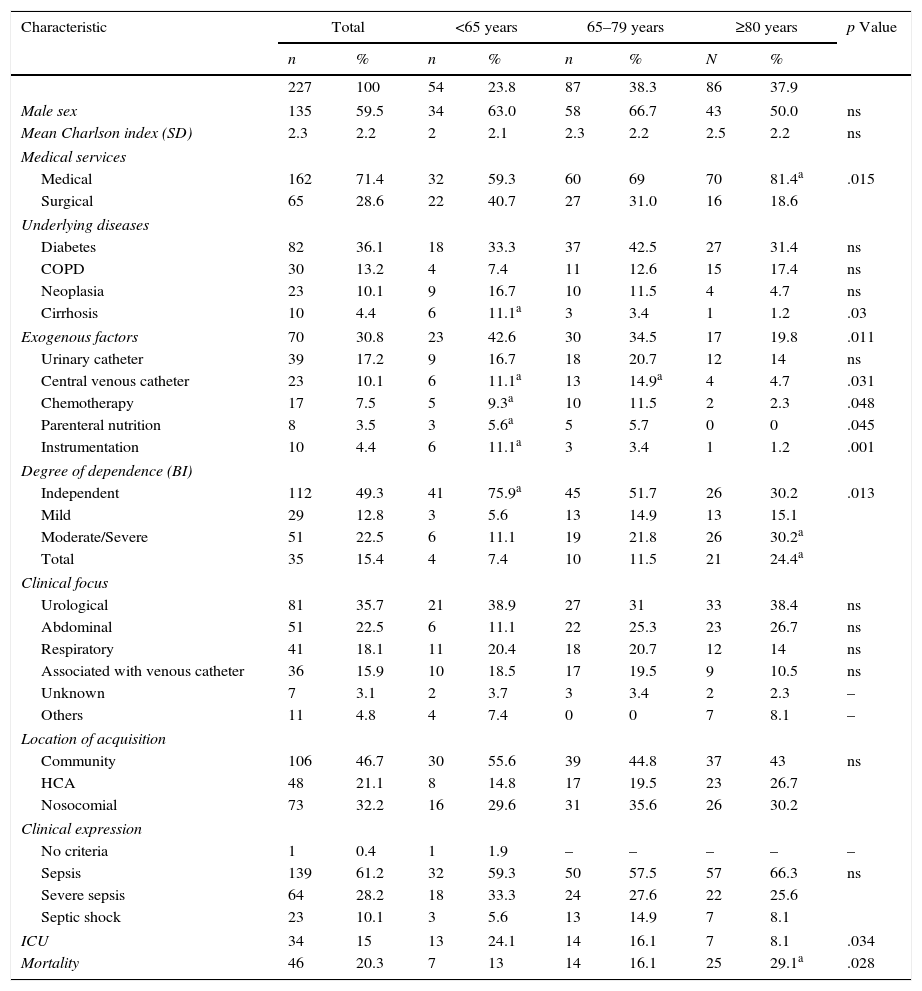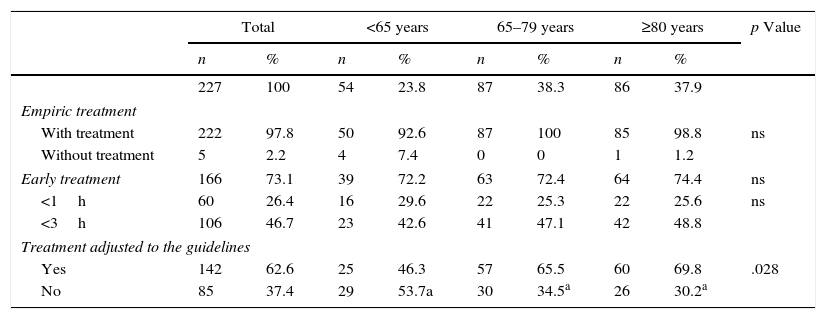To describe the characteristics of bacteraemias, according to age, in a community hospital.
Material and methodA prospective study of bacteraemias was conducted in 2011. The patients were classified into 3 age groups: younger than 65 years, 65–79, and 80 or older. The study collected variables on the patients and episodes.
ResultsThe study analyzed 233 bacteraemias in 227 patients (23.8% in those younger than 65 years; 38.3% in the 65–79 age group; and 37.9% in the 80 years or older group). The most common underlying disease in all the groups was diabetes mellitus. In the most elderly patients, the Charlson index was highest, there were a lower proportion of exogenous factors, and almost 25% were severely dependent (Barthel index <20). Escherichia coli was the most common germ, and the main focus was urological. The patients aged 80 years or older had predominantly healthcare-associated infections, less severe symptoms (sepsis) (66.3%) and higher mortality (29.1%) compared with the younger patients.
ConclusionsThe very elderly patients with bacteraemia presented fewer exogenous factors, greater comorbidity and a poorer functional situation. The most common focus was urological and the origin was healthcare related. Despite their less severe clinical presentation, these patients’ mortality was greater, and their degree of dependence was a highly relevant independent risk factor.
Describir las características de las bacteriemias, según la edad, en un hospital comunitario.
Material y métodoEstudio prospectivo de las bacteriemias en el año 2011. Los pacientes se clasificaron en 3 grupos de edad: menos de 65, de 65 a 79 y 80 o más años. Se recogieron variables de los pacientes y de los episodios.
ResultadosSe analizaron 233 bacteriemias en 227 pacientes (23,8% en<65; 38,3% entre 65 y 79; y 37,9% en≥80 años). La enfermedad de base más frecuente en todos los grupos fue la diabetes mellitus. En los pacientes muy ancianos el índice de Charlson fue mayor, hubo una menor proporción de factores exógenos y casi un 25% eran dependientes graves (índice de Barthel<20). Escherichia coli fue el germen más frecuente y el foco principal fue el urológico. En los pacientes≥80 años predominó el origen de la infección asociado a cuidados sanitarios, la expresividad clínica menos grave (sepsis) (66,3%) y la mortalidad más elevada (29,1%), respecto a los de menor edad.
ConclusionesLos pacientes muy ancianos con bacteriemia presentaron menos factores exógenos, más comorbilidad y una situación funcional peor; el foco más frecuente fue el urológico y el origen el asociado a cuidados sanitarios. A pesar de que su presentación clínica fue menos grave, su mortalidad fue superior, siendo el grado de dependencia una variable de riesgo independiente muy relevante.
Article
Diríjase desde aquí a la web de la >>>FESEMI<<< e inicie sesión mediante el formulario que se encuentra en la barra superior, pulsando sobre el candado.

Una vez autentificado, en la misma web de FESEMI, en el menú superior, elija la opción deseada.

>>>FESEMI<<<











